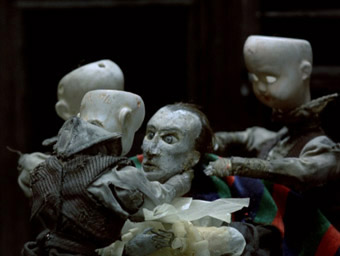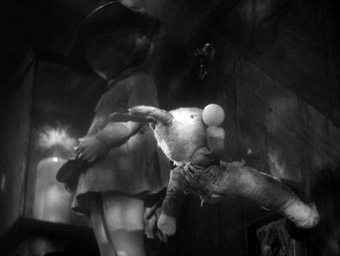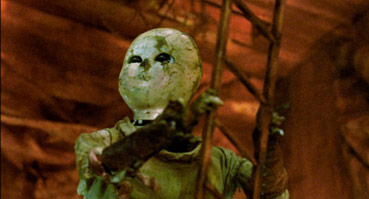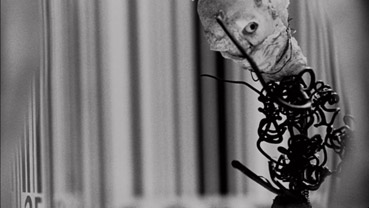|
What
was it that scared you as a kid? I'm not talking about the
tangible things of childhood, like going to the dentist, or angry
dogs, or getting caught lying to your Mum, but the stuff
that crept into your head when the lights went out and you
tried to get to sleep, that messed with your brain and made
you imagine you heard or saw things in the darkness. I'll
wager you can remember the feeling but not the specifics.
That's certainly how it is with me. But every now and then,
all these years later, something will trigger off a vivid recollection of those solitary moments in the dark.
Art,
in all its forms, is uniquely placed to capture the essence
of such abstract sensations. It can present an idea, an emotion
or a memory in physical form for the interpretation and recognition
of others. When it works – and it's a subjective experience
every time – it can catch you by surprise. The first time
I saw a photograph of Salvador Dali's mannequin sculpture
'Rainy Taxi', for example, I was seriously freaked out, and
for the life of me couldn't rationally explain why. It tapped
into an irrational fear that I am still unable to explain,
something dragged up from long ago nightmares, things back
there in the dark.

And
then there's film. My first encounter with Buñuel
and Dali's Un Chien
Andalou was a disturbing one, not just for
the notorious opening eye-slicing, but for the experience
of seeing subconscious and unconscious imagery made flesh and
realising that my own experiences in this realm were not
unique. The Surrealist movement specialised in this, tapping
into the unconscious through recalled dream imagery and
the juxtaposition of unrelated objects and ideas, order
usurped by a strangely logical chaos. Over
the years, my subconscious childhood terror triggers began
to pile up: reality disassociation, decay, harm inlicted on eyes, creatures with oversized heads (my horror of
babies stems partly from this), mannequins, dolls or statues
that move on their own, anything with no eyeballs, gaping wounds,
people or animals with the top of their head missing...
If
you want to get me on a discussion panel, I am quite prepared
to argue the case for the animated short as the richest
and most exciting of modern artistic forms (see the opening
paragraph of my review of Fantastic
Planet for a capsule summary of my reasoning).
Often the result of the artistic passions of one or two
fiercely dedicated individuals, such films can unite and
draw on a wide range of artistic forms, including painting,
sculpture, literature, set design and lighting, and then
make the resulting creation move, breathing life into inanimate
objects and imbuing them with human or animalistic characteristics,
in the process transforming the real into the surreal. I
was on the brink of becoming a devotee of this art form
when I first discovered Street of Crocodiles.
Plenty of films before, both animated and live action, had
contained the odd unexpected terror trigger – the statue
of Talos turning its head just a little in Jason
and the Argonauts, a chest of drawers thundering
towards the camera in The Exorcist, Henry
Spencer's horrible baby in Eraserhead
– but this one was just bristling with them. It's hard-to-fathom
plot took us inside an archaic mechanical device, where
a gaunt, mannequin-like figure explored a greying, cluttered
and semi-abstract world that was riddled with decay, where he encountered
– horror of horrors – animated dolls with no eyes and the
tops of their heads missing. Several of them. Unaware at
that time that these creatures were something of a signature
for these particular animators, I was left with the sneaking
suspicion that the Brothers Quay, whomever they may be, had
crawled into my head one night, spent a few hours making
extensive notes, then spent eight months constructing a
work specifically designed to stick artistic pins into my
shudder centre.
It
was this film specifically that really kickstarted my fascination
with the animated short as the modern art form.
For about three years solid I taped just about every such film that TV was kind enough to throw at me, and in the
process discovered the works of such animators as Clive
Whalley (And Now You), David Anderson (Deadsy,
Door), Andrew McEwan (Toxic)
and the mighty Jan Svankmajer. The work of the Quays has
often been linked to that of Svankmajer, despite the clear
difference in the style and content of their films. It's
hardly surprising – both employ stop motion to surrealistic
effect, both have successfully combined animation with live
action, both are heavily influenced by Eastern European
and specifically Czech art and culture. And from a personal
perspective, the arrival of a new film from either party
was soon to prove an annual high point.

So
distinctive is their approach and style that almost every
Quay Brothers film is instantly recognisable as their work.
Specific elements recur and evolve throughout their filmography
– the use of sometimes strangely constructed puppets that
move fluidly and realistically, eyeless dolls that are battered
with age and missing the tops of their heads, stylised and
almost dreamlike settings, the workings of archaic machinery,
the use of focus pulls and swift, almost mechanical camera
movements, an absence of dialogue and a striking marriage
of imagery with music. The storyline of the average Quay
film is largely a springboard for visual and aural experimentation
and can prove initially elusive or even completely obscure,
but it never seems to matter. You'll probably be three or
four viewings into Street of Crocodiles
before you even care to look for meanings, so dense and darkly
beautiful are the settings and characters and so divine
the animation. Search for narratives in The Comb
or Rehearsals for Extinct Anatomies and
you're likely to end up with a headache. Watch them for
their astonishing artistry, for the richness of their subtextual
suggestion, or their ability to disturb without recourse
to narrative crutches or emotional manipulation, and you
will be astonished.
The
debate over whether film can ever be really classified as
an art form to stand alongside painting or sculpture still
occasionally rears its head, but in the face of such work
it seems absurdly obvious. This is film as art, as beautiful, visionary,
challenging, intricate and stimulating as anything you find
in a gallery or museum, and I'm not remotely interested
in arguments to the contrary. Playing at times like Grimm
fairy tales performed by the Royal Ballet by way of Hieronymus
Bosch, and filtered through the veil of a dream, these are
films that tap directly into our inner child. Not the fluffy,
innocent one so beloved of Hollywood, but the scared little
kid who peeks nervously into the closet and knows that,
despite what they've been told, there really are monsters
in there.
The
problem for animated shorts, especially experimental ones,
is that there is no ready-made venue for their exhibition
and appreciation. They almost never play in cinemas, are
rarely shown on TV, and can be a swine to track down on any home
video format. At the time of my real awakening to the
form, Channel Four were doing a marvellous job of funding
and screening such work, and in the one dealing I had professionally
with their animation unit, I encountered a group of real
enthusiasts who were only too keen to do what they could
to help you locate specific films for cinema projection.
Oh how things have changed. In the world of post-Big
Brother Channel Four, animation is largely restricted
to showing cut episodes of The Simpsons,
and the Quays themselves have expressed disappointment at
the demise of such enthusiastic funding sources. I can thus
wax lyrical over how brilliant Raoul Servais's Harpya
or Geoff Dunbar's Ubu or Philip Hunt's
Spotless Dominoes are, but with the sad
knowledge that you'll probably never get to see any of them.
Which makes DVD releases such as this one all the more important.

A
few years ago, Kino Video in the USA released a Quay Brothers
collection on DVD that may not have been perfect, but given
the difficulty of locating some of their films it was nonetheless
welcome. It seems typical that I should chance across the
disc not through web browsing or active research, but while
browsing the shelves in a small video shop in Tokyo's Shinjuku district,
where I found it tucked inside a small bucket of imported discs. For
almost three years it has been a treasured possession, but
now I've had cause to stick it back on the shelf. It has,
shall we say, been superseded. And how. This two-disc set
from BFI Video is as close to a definitive DVD presentation
of the Quays' work as you're likely to encounter. The only things missing are the films they haven't made
yet. The short films themselves are on Disc 1, so I'll deal
with that first.
The
Cabinet of Jan Svankmajer (1984) (13:40)
Actually part of a 54 minute documentary on the titular Animator
of Prague, this has a livelier music score (by Zdenek Liska)
than in the later Quay films, but many of the other stylistic
signatures are already taking shape, not least the set design,
the use of suggestive title cards, and the character animation.
I have no doubt that the title is at least partly responsible
for the frequently quoted link between the Quays and Svankmajer,
especially with a plot that has a Prague-based master taking
on a pupil (the Quays themselves, perhaps?)
and instructing him in the ways of his art.
This
Unnameable Little Broom (1985) (10:45)
Described at the start as "a largely disguised reduction
of the Epic of Gilgamesh," the Quays' take on the one
of the earliest of literary works sees their style developing
further, with some fabulous production design, very fluid
and realistic animation, and rapid mechanical camera movements.
Street
of Crocodiles (1986) (20:35)
Pure poetry whispered into the ear in the dead of night,
this is guaranteed both to delight and disturb. Everything
comes together here in breathtaking harmony, the beautifully
fluid animation, decaying shop-front sets, atmospheric lighting,
and of course, those creepy eyeless dolls. The mood is further enriched
by the first of many collaborations with composer Leszek
Jankowski. One IMDB contributor wrote that if you only see
one Quay brothers film, then make it this one, but see it
and you'll want to watch everything else they were ever
associated with. Despite the remarkable works they have
created since, this remains my favourite.
Rehearsals
for Extinct Anatomies (1987) (13:56)
One of the Quays' most baffling pieces is also one of their
most visually striking and suggestive. Shot in monochrome
widescreen, the black-line-on-white motif that runs throughout
has calligraphic origins, but expands to suggest string
instruments, threads and hair, and even the bars of a prison
cell. With a stark but arresting décor that is dedicated
to "London Underground as part of its present evangelical
rampage," it makes for unsettling viewing, the image
of a forehead mole being repeatedly rubbed having a particularly
troubling quality.
Stille
Nacht 1 – Dramolet (1988) (1:45)
The first of four monochrome shorts that abstract a single
moment, this feels as much like an experiment as anything
the Quays have done, springing from their discovery of just
what you could do with iron filings and magnets. Once again,
the production design and animation are excellent.
The
Comb (1990) (19:23)
Divinely
baffling short film number 2 is the first Quay film to integrate
live action sequences fully into the narrative (the opening
of Street of Crocodiles is more a prelude),
although quite what is going on here is open to multiple
interpretations. An inversion of the Matter
of Life and Death colour scheme presents the
real world in dreamy monochrome and an under/overworld
that is rich in orange hues, inhabited by creatures who appear to
be advancing on and taking control of an earth-bound sleeping
girl.

Anamorphosis
(1991) (13:45)
A short documentary with voice-over on the technique of
the title, which involves illustrating objects in a distorted
fashion so that they appear geometrically correct only when
viewed from a specific angle. A technique that has been
in use for centuries, sometimes to include coded images
in paintings or drawings, it has been adapted more recently
for surprisingly everyday use (signs painted on road surfaces,
sponsorship logos dyed onto cricket pitches). This is a
fascinating introduction to the process.
Stille
Nacht II – Are We Still Married? (1992) (3:19)
One of the first Quay Brothers films I saw and still one of my favourites.
At a time when British indie label 4AD were putting out
some of the most interesting music around, it should not be completely
surprising that two of animation's most talented artists
agreed to create a music video for one of their releases
– Are We Still Married? by His Name is Alive. Again
focussed on a single moment – a young girl stands against
a door preventing the entry of a second party – it is abstracted
in mesmerising and unexpectedly playful fashion, as a white
door knob flies from its housing and becomes a ball to be
batted, the girl repeatedly stretches her legs to stand
on tip toe, and her actions and that of the would-be intruder
are mimicked by an excitable rabbit. Delightful in itself,
its marriage of image to sound is georgeous.
Still
Nacht III – Tales From Vienna Woods (1992) (4:10)
A gun is fired and a bullet flies through the surrounding
forest, a dramatic moment that the Quays still manage to
transform into dream imagery.
Still
Nacht IV – Can't Go Wrong Without You (1993) (3:47)
A second song from His Name is Alive revisits the imagery
and characters of Are We Still Married?, although
we appear to be presented at one stage with an alternative
viewpoint of the previous film's action, that of the would-be intruder.
Again, a playful and deliciously inventive piece with
some suggestive undertones.
In
Absentia (2000) (19:20)
In a room penetrated by shifting light, a white-dressed
woman takes a pencil from a drawer, sharpens it, and starts
to write a letter. Boasting a slightly (and only slightly)
more conventional narrative structure than the Quays' previous
films, In Absentia develops in enigmatic
but largely opaque fashion. Unexpected clarity is provided
in the final moments, which should prompt an immediate second
viewing to appreciate the clear purpose of what initially
seemed random and dreamlike. Shot in graphite pencil greys
and set to a brilliant, sensory-battering score by Karkheinz
Stockhausen, it illustrates a steady shift towards live
action following their first feature, Institute
Benjamenta (1995). A mesmerising piece.
The
Phantom Museum (2003) (11:17)
Subtitled "Random forays into the vaults of Sir Henry
Welcome's Medical Collection," this is as close to
a cinematic coffee table book as the Quays will probably
ever come, a gentle drift through some of the more unusual
objects in this collection, which white gloved hands hold
up for us and even demonstrate their function. There is,
save for the trips to and from the location, no abstraction
or surrealism, and there is an almost leisurely feel to
the animation, though anyone who has done any stop motion
work will never associate such a term with the process of
its creation. It's still interesting for its content, but
surprising in its tone.
All
of the films here have been restored and remastered for
this DVD release and it shows. Picture quality throughout
is excellent – Street of Crocodiles looks
better than I've ever seen it, and contrast and detail on
the Stille Nacht shorts and Rehearsals
for Extinct Anatomies as close to perfect as you
could hope for, while the absence of solid black levels
on In Absentia is clearly deliberate. Some
grain is evident on The Comb, but this
is never a problem. Most of the films were shot 4:3 and
are presented in this aspect ratio – Rehearsals
for Extinct Anatomies, The Comb,
In Absentia and The Phantom Museum
are presented anamorphic widescreen.

All
soundtracks are Dolby 2.0 with very clean transfers and
clear presentation of music and sound effects (dialogue
is rarely an issue here). I couldn't help wondering what
In Absentia's music would have done to
my nerves in 5.1...
Disc
2 boasts a whole cabinet of features, but before I get to
them there is one very important extra on the first disc
that alone should have Quay fans scrabbling for their credit
cards: Commentaries by the Quay
Bothers themselves on The Unnameable Little Broom,
Street of Crocodiles, Stille Nacht
II, Stille Nacht III and In
Absentia. All of these are excellent, providing
a welcome insight into the approach, production, the technique
and background of the films. Their comments on Street
of Crocodiles and In Absentia
are especially enthralling and I'm not just saying that
because these are two of my favourites – the Brothers are
enthusiastic speakers with plenty to say, and there
will be few who do not learn something new while listening
to them. And get this – they're all subtitled for the hearing
impaired. A wonderful inclusion.
DISC
2: Footnotes
BFI
Distribution Ident (1991) (0:19)
It is what it says. The only extra which has dust and sound
crackle, but I have a sneaking suspicion that this is intentional
(I find it hard to believe the BFI wouldn't have a pristine
copy of their own ident).
Introduction
by the Quay Brothers (2006) (20:31)
An interview with the Quays, in which they discuss their
career, the influence of Polish posters and Kafka, their
move to Europe and to the Royal College of Art, their first
film, and a whole lot more. Essential stuff.
Nocturna
Artificiala (1979) (20:34)
The oldest surviving Quay film may appear primitive by comparison
to the later works, but the seeds have clearly been sewn
here, and the use of light and titles and even camera movements
definitely point the way forward.
The
Calligrapher (1991) (1:08)
Three idents commissioned for BBC2's re-branding back in
1991, all of which were rejected. Just why remains a mystery.
The
Summit (1995) (12:31)
A short pilot for a 70 minute performance by Barnaby and
Jonathan Stone – who worked under the name of Ralf Ralf –
made shortly after the completion of Institute Benjamenta.
The picture and sound quality are not great, having been
transferred from low band video, but the performance itself
is fascinating, an exploration of the emotions and body
language of political debate and rhetoric. Shot for Channel
4, who rejected it. I see a pattern emerging here...
The
Quays' interest in anamorphosis has led to them regularly
screening some of their films in a stretched format, widescreen
expanded to scope through the use of anamorphic projection
lenses. At their request, scope versions of both Rehearsals
for Extinct Anatomies and In Absentia
have been included here. If you want to try it on The
Comb, change the settings on your DVD player to
output a letterboxed picture to 4:3 and then switch the
TV picture to 16:9 and you'll get the same effect. Both
transfers are as well presented as the widescreen originals.
The
Falls (excerpt) (1980) (4:54)
A short excerpt from Peter Greenaway's encyclopaedic film,
in which the Quays appear in still pictures as twin brothers
Ipson and Pulat Fallari. The inclusion of this extract adds
to the feeling of completism and should at least prompt
a few viewers to hunt out Greenway's film.
Archive
Interview (2000) (28:34)
Conducted by French critic Yves Montmayeur at the Paris
Doll Museum, this is presented in its unedited form and
thus has a few camera ticks and a couple of pauses, but
is still interesting stuff, not least for the uncanny way
the Brothers finish each other's sentences or simultaneously
arrive at the exact same word. There is plenty here that
is not covered in the commentaries or other extras, a particular
favourite of mine being their bemusement at the very idea
of Quay Brothers merchandising.
The
final extra is not on either of the discs, but takes the
form of a Booklet, which contains
a reproduction of the Quays' original treatment for Street
of Crocodiles, and a Quay Brothers Dictionary,
which usefully expands on many of the things touched on
only briefly in the commentaries and interviews, and provides
us with the correct pronunciation of the name 'Quay'.
Speaking
as a long time fan of the films of The Brothers Quay, I
was seriously excited by the prospect of this two-disc set,
but I have to say that it exceeds my wildest expectations.
The transfers are excellent and the extra features both
numerous and consistently high in quality. Whatever Quay
related video or DVD material you already have, shelve them
and buy this instead – you will not be disappointed. If
you are new to their work, and many of you probably will
be, then there has never been a better time to discover
why it is held in such high regard. A superb package,
and one of the essential DVD releases of the year.
|